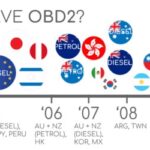Experiencing issues getting your 2009 Honda Civic to pass an emissions test? It might be related to your OBD2 system’s readiness monitors not being set. These monitors are crucial for ensuring your vehicle’s emission control systems are functioning correctly. This guide will walk you through the OBD2 drive cycle specifically for your 2009 Honda Civic, helping you reset these monitors and prepare for your smog test.
Preparing for the 2009 Honda Civic OBD2 Drive Cycle
Before starting the drive cycle, ensure your 2009 Honda Civic meets these conditions for a successful procedure:
- Cold Start: The engine must be cold. This means the coolant temperature should be below 122 degrees Fahrenheit (50 degrees Celsius), and the air and coolant temperature sensors should be within 11 degrees Fahrenheit (6 degrees Celsius) of each other. It’s important that you do not turn the ignition key to the ‘ON’ position before starting the engine for the cold start, as this can prevent the heated oxygen sensor diagnostic from running properly.
- Fuel Level: Ensure your fuel tank is between 1/4 and 3/4 full.
Step-by-Step 2009 Honda Civic OBD2 Drive Cycle
Follow these steps precisely to complete the OBD2 drive cycle in your 2009 Honda Civic:
Step 1: Initial Idle
Start the engine and let it idle in drive for two and a half minutes. During this step, turn on the air conditioning (A/C) and the rear defroster to increase the engine load. This allows the OBD2 system to check the oxygen sensor heater circuits, air pump, and EVAP purge system.
Step 2: Acceleration and Steady Speed (55 mph)
Turn off the A/C and rear defroster. Accelerate smoothly to 55 mph (88 km/h) at half throttle. Maintain a steady speed of 55 mph for three minutes. During this phase, the OBD2 system checks for ignition misfires, fuel trim, and canister purge. It also monitors the EGR system, air pump, oxygen sensors, and canister purge functions.
Step 3: Deceleration
Decelerate by coasting down to 20 mph (32 km/h) without applying the brakes or depressing the clutch. This step allows the OBD2 system to check the EGR and purge functions during deceleration.
Step 4: Re-acceleration and Steady Speed (55-60 mph)
Accelerate again to 55 to 60 mph (88-96 km/h) at half throttle. This step, similar to Step 2, re-checks for misfires, fuel trim, and purge system operation under acceleration and load.
Step 5: Extended Steady Speed (55-60 mph)
Hold a steady speed between 55 and 60 mph for five minutes. In this extended steady-state driving condition, the OBD2 system monitors critical emission control components, including catalytic converter efficiency, misfires, EGR, fuel trim, oxygen sensors, and purge functions.
Step 6: Final Deceleration and Idle
Decelerate and come to a complete stop without braking, if safe to do so. Let the engine idle for a further two and a half minutes in drive. This final idle period allows the OBD2 system to conduct a last check of the EGR and canister purge systems.
Completion of the Drive Cycle
After completing all steps, the OBD2 drive cycle for your 2009 Honda Civic should be finished. It’s recommended to use an OBD2 scanner to check if your readiness monitors are now set. Keep in mind that sometimes it might take more than one drive cycle to set all monitors.
Disclaimer: This guide is for informational purposes and intended for 2009 Honda Civic vehicles. Always consult your vehicle’s repair manual or a certified mechanic for specific diagnostic and repair procedures. Safety should be your top priority when performing a drive cycle; always adhere to local traffic laws and road conditions.
